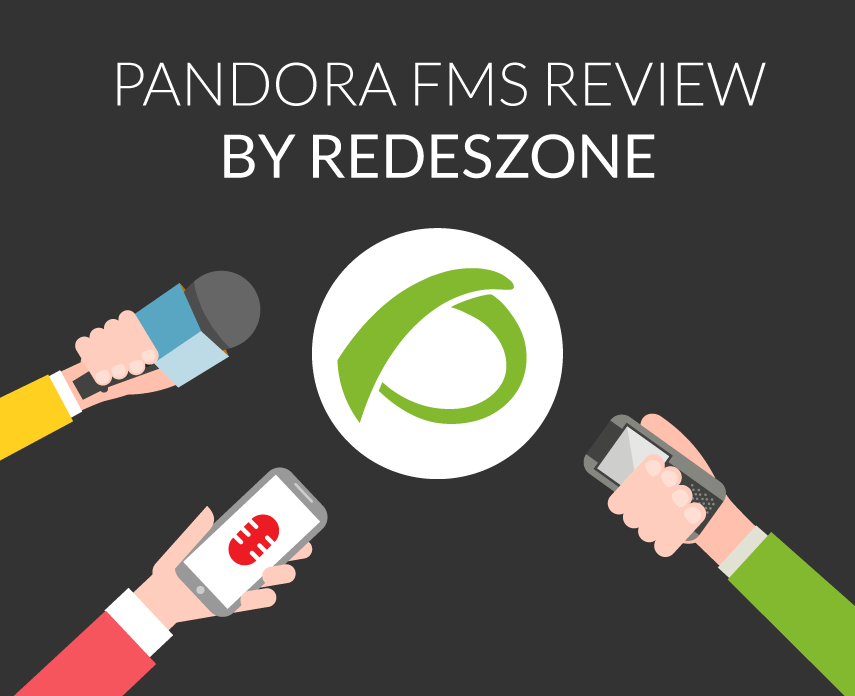Back in February of this year we reached out to Ruben Velasco, editor at RedesZone, one of the most important Spanish-language sites dealing with networks, to give him a tour of Pandora FMS, our flagship product. For a while we’d been reading their interesting articles about networks and monitoring and we wanted to meet them and get their opinion on Pandora FMS.
Here at Pandora FMS we’re always looking for people to collaborate with on our software, whether it be in a hands-on capacity or with their ideas, and help us to continue to compete nationally and internationally. That’s why we started the Pandora FMS Ambassadors Project back at the beginning of 2016, as a way to listen to monitoring specialists who would like to contribute to Pandora FMS.
Ruben told us straight up that he would take a look, and give us his feedback, and after he put Pandora FMS through its paces, we got the following article. This time we want to dig deeper down, as it’s not every day an expert in the field donates their time to test your tool and give you an honest opinion.
That’s why we ended up interviewing Ruben and Sergio de la Luz, editor and director at RedesZone, to get a full and honest Pandora FMS review, constructive criticism included (and always welcome!).
Conclusions
Following on from Sergio and Ruben’s generous feedback, we’re working on improving the configuration of Pandora FMS, to make it more simple and intuitive. We’re also looking at the possibility of incorporating basic SMS-messaging, and also integrating with other messaging platforms such as Twitter or Telegram.
We were especially pleased to hear how our tool Pandora FMS stacks up against familiar monitoring software, such as Nagios and Zabbix, and where Ruben and Sergio think it supersedes them.
Transcription of the Redes Zone Interview/ Pandora FMS
Axel: What’s your opinion on Pandora FMS?
Rubén: Ok, well I spent quite a bit of time with it, trying it out, and the truth is, it seems like a very comprehensive tool, and just really good in all aspects. It may be a little difficult to configure, and that’s definitely where you spend the most time, in configuring all the modules and sensors, but, as for the rest, I was surprised, comparing it with other monitors which only monitor a website, or a server or an application, at just how much it can do.
Javier: What did you find difficult in the configuration process?
R: Maybe “difficult” isn’t the right word, but it takes a long time to configure, it’s a long process, although everything is explained clearly on the dashboard and in the documentation.
Sergio: I love the documentation; that it’s all in Spanish (1). That’s great for Spanish speakers. Nagios has books and docs spread around user-forums, but it’s all in English. The Pandora documentation is great, and easy to understand, even for someone not familiar with this kind of software it gets them started quickly, and gets the monitoring up and running.
J: Any ideas on how we could simplify the configuration of modules and sensors?
R: As it’s such a comprehensive piece of software, I don’t think there’s really a way to simplify or shorten the process. It’s part of the package when you’re dealing with a tool which is able to monitor so many different aspects of a network. One thing which occurs to me is to include a series of templates, with basic default configurations, and which you can tweak later, if you need to change the parameters.
A: I’m product manager at Pandora and this is my most pending of pending tasks! I don’t know if you had time to look at some of the functions which include default elements from Windows or Debian. We’ve also grouped some network modules into templates, but that is from a while ago, and we need to update those, and also to add more vendors and brands to Pandora FMS, for example, manufacturers of network devices or operating systems. Note taken, we are working on it, and I’m glad you bring it up, as it shows we’re on the right path.
J: Ruben, where does your passion for monitoring come from, and what brought you to where you are now?
R: I’ve always been interested in the world of IT, as a hobby, and later as a student of Telecommunications and IT. I’m always looking at stuff online, everything to do with networks, monitoring, Linux operating systems, servers and all that. I have virtual machines to run different tests, mount servers, web servers…working with servers in general, investigating and trying things out.
That reminds me, you gave me an ISO with Centos, which, in theory, worked in Live mode, but I had problems installing it in Virtual Box, and the graphic dashboard didn’t load. Once it was installed there were no more problems.
A: Yeah, we’re aware of that. It’s related to generating ISOS. We know it’s there.
R: I just remembered that the activation process is a little confusing. You sent the password, I tried to activate but nothing. First you had to generate the password, and then, with that password, activate with the assistant. That could probably be simplified or explained in a text.
A: It is a little confusing, you’re not the first to point that out. I’ve taken note.
J: So what kind of system did you monitor for the Pandora FMS review? Do you have a lab with different servers and PCs, running different OSs and applications? You always try to run the same tests in the same environment, is that right?
R: Yes, like I said before, I run virtual PCs in Virtual Box, and connect the virtual network with my home set-up. Everything’s monitored virtually from Virtual Box.
J: Did you get to monitor any applications?
R: No, I concentrated mostly on servers and networks. Well, I monitored the status of Redes Zone when the virtual machine wasn’t running. It takes up a lot of RAM otherwise.
S: We use Nagios for application monitoring. I’ll take a look at Pandora FMS’s application monitoring, because if it does a better job, and the dashboard is better I’ll migrate to your system.
A: So let me give you a tip; we have a wrapper for Nagios server plugins, which adapts to them, and makes migrating from one system to the other a lot easier.
S: So you don’t have to create new ones.
A: Exactly, it’s one benefit of migrating from Nagios, that you don’t lose the work you’ve already done.
S: We use existing plugins and others we’ve had to make ourselves, adapting them to our needs, let’s say.
J: Sergio, regarding training, we’re also working on that, preparing courses about monitoring, specific training with our software, and how to use it.
S: Yo el tema de la monitorización lo daré las últimas semanas de curso, podemos verlo sobre la semana del 6 o 13 de junio. Primero tengo que enseñarles el tema de servicios que digamos y luego ya monitorizar ellos.
J: Speaking about making improvements, Ruben’s already mentioned the configuration process, and the default templates. I’d like to ask you if there’s anything we could include on Pandora FMS which any good monitoring system should have?
S: Does it have alerts via SMS?
A: Yes, Pandora FMS can integrate with SMS, but you need to have a third-party GSM platform connected to the server, which isn’t very practical. We’d like to update it to include the typical gateways, so popular at the moment, but out-of-the-box, it’s with GSM platforms.
S: Just like Nagios. The ideal solution would be to provide a tool with various SMS services, to be totally transparent and that doesn’t need a 3G or 4G modem installed in the server. But…
A: Exactly…
S: That would be really useful, and I’d actually go further. You could integrate alerts via Twitter, as it has an open API, and cut out the need to do it manually with a plugin. That would be a great default service.
A: Right. We’re looking for new functions but Twitter hadn’t occurred to us. We’ve got that function for Slack and Mattermost, but not for Twitter, and the API it uses isn’t complicated. Great idea!
S: Sure, you create a Twitter account to receive your alerts and you’re good to go. Integrating Telegram would also be a clever idea. You could also send alerts to groups, which would be ideal. Not only by Telegram, but also by email, SMS, Twitter, etc. These kinds of services would add value to the product.
J: Great! And any other extras you’d like to see? you guys have a lot of experience with monitoring, how can we stand out from the rest?
R: Off the top of my head I can’t think of anything.
S: I think it has everything. It has the best of what’s available at the moment, like Nagios and ICINGA, but with a better user-dashboard for managing alerts. Adding some value through integrating messaging services and simplifying the configuration wouldn’t be difficult to develop.
A: And you’re saving the end user time.
S: The administrator, most of all.
A: Everybody wins.
J: What do you think is the future of monitoring? Where should it go from here?
S: The future of monitoring is here right now. It’s necessary, and it’s not going away.
J: One more thing. How does Pandora FMS compare to other monitoring systems? Not in a strictly commercial sense, to push our product, but in an objective sense, talking about the good and bad points of each tool, and what kind of monitoring each one is best at. For example, in our comparison of Nagios, Cacti and Pandora FMS, what would you like to read?
S: Cacti in itself isn’t a monitoring system, it only generates graphs. It needs to be supplemented with Nagios.
J: Ok, so; Nagios and Zabbix.
S: I know, for example, Nagios and ICINGA. When I have time for a more in-depth look at Pandora we can talk comparisons, and if Ruben installs Nagios we can get his point of view on how it compares.
R: Ok, I’ll install it.
J: Thanks for everything.
R: Thank you for letting us try it.
Pandora FMS’s editorial team is made up of a group of writers and IT professionals with one thing in common: their passion for computer system monitoring. Pandora FMS’s editorial team is made up of a group of writers and IT professionals with one thing in common: their passion for computer system monitoring.
















